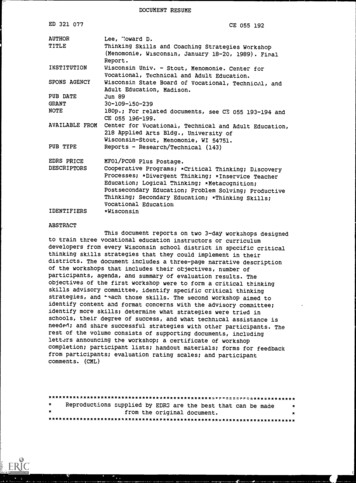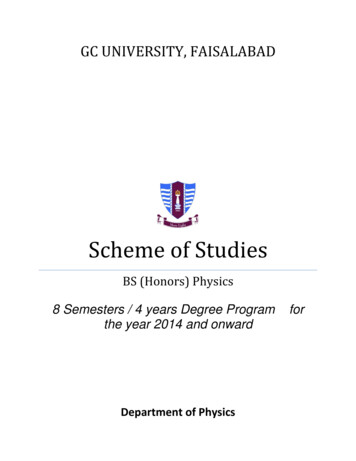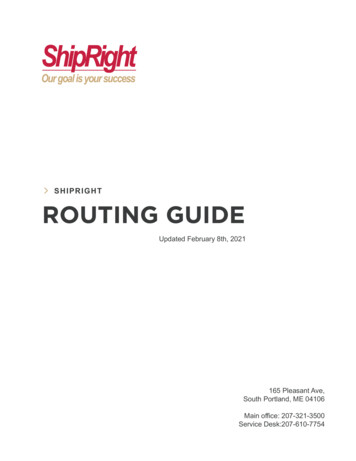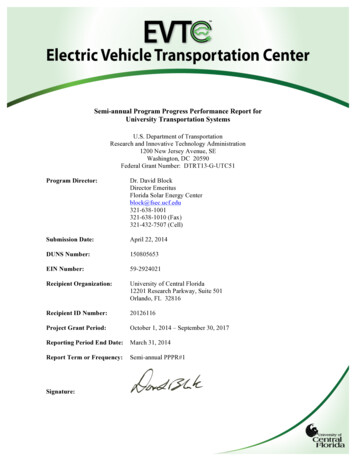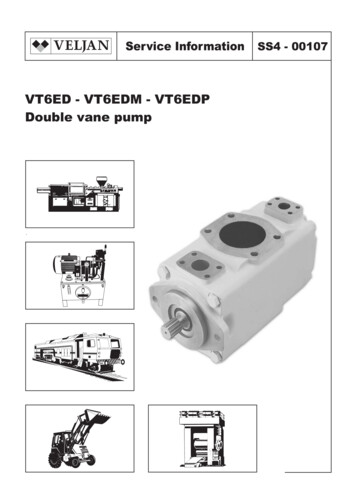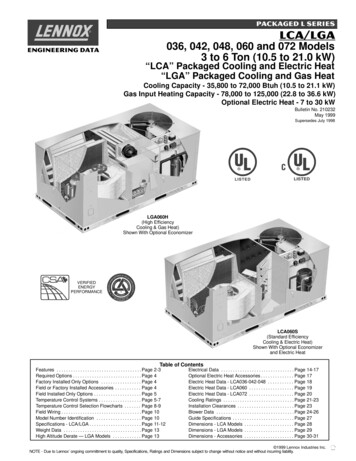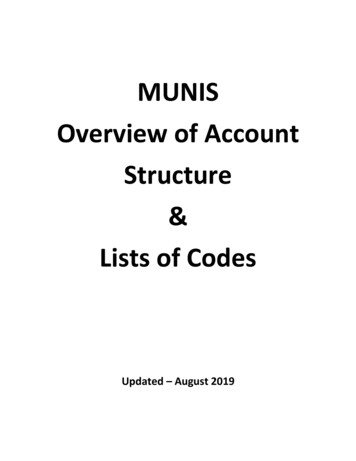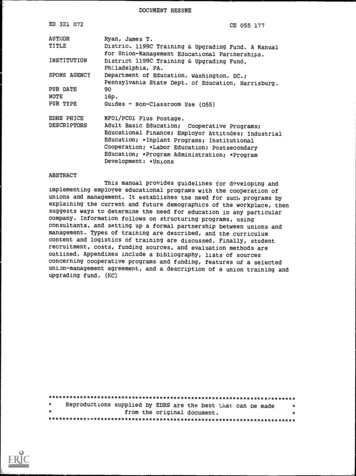
Transcription
DOCUMENT RESUMEED 321 072AUDIORTITLEINSTITUTIONSPONS AGENCYCE 055 177Ryan, James T.Distric, 1199C Training & Upgrading Fund. A Manualfor Union-Management Educational Partnerships.District 1199C Training & Upgrading Fund,Philadelphia, PA.Department of Education, Washington, DC.;Pennsylvania State Dept. of Education, Harrisburg.PUB DATENOTEPUB TYPE9016p.EDRS PRICEDESCRIPTORSMF01/PC01 Plus Postage.Adult Basic Education; Cooperative Programs;Educational Finance; Employer Attitudes; IndustrialEducation; *Inplant Programs; InstitutionalCooperation; *Labor Education; PostsecondaryEducation; *Program Administration; *ProgramDevelopment; *UnionsGuides - Non-Classroom Use (055)ABSTRACTThis manual provides guidelines for developing andimplementing employee educational programs with the cooperation ofunions and management. It establishes the need for such programs byexplaining the current and future demographics of the workplace, thensuggests ways to determine the need for education in any particularcompany. Information follows on structuring programs, usingconsultants, and setting up a formal partnership between unions andmanagement. Types of training are described, and the curriculumcontent and logistics of training are discussed. Finally, studentrecruitment, costs, funding sources, and evaluation methods areoutlined. Appendixes include a bibliography, lists of sourcesconcerning cooperative programs and funding, features of a selectedunion-management agreement, and a description of a union training andupgrading fund. *****************P********Reproductions supplied by EDRS are the best than can be made**from the original *******************************
''taI('-clots/aDISTRICTbCD----11r--71111a-g Pgracfing Fund7.--(G9anANl&0DEPARTMENT OF EDUCATIONe of Educateonal Research inn ImpovementUCAT1ONAL RESOURCES INFORMATIONCENTER (ERIC)This document has been reproduced asreceived from thi person or organizationOriginating it0 Minor changes have been made to improvereproduction qualm,* Points of view or "pinions stated in this docu-ment do not necessarily represent officialOERI position or policyN.N.toli)0%VIIESHJPYAVAILABLE
.A Manual for Union-Management Educational PartnershipsJames T. Ryan, Ph.D.This booklet is a result of a project supported in part by the U.S. Office ofEducation and the Pennsylvania Department of Education. However. theopinions expressed herein do not necessarily reflect the position or policy ofthe U.S. Office of Education or the Pennsylvania Department of Education,and no official endorsements should be inferred. Nevertheless, the supportof Dr. John Christopher, the Chief of Adult Basic Educatic s. and his staff isappreciated.The following experts in adult education were generous enough toreview the draft of the booklet:Eunice N. AskovJack L. ErnsbergerChristopher McCarthyThelma ReeseTony SarmientoWilliam J. SchwabeJo Ann WeinbergerThey made excellent suggestions which I have attempted to do justice.The District 1199C Training & Upgrading Fund's 15 years of experiencehas provided much of the material for this work. The Trustees, union andmanagement, have created an innovative and effective training program forworkers. The co-chairmen are Henry Nicholas, President of the NationalUnion of Hospital and Health Care Employees, AFL-CIO and R. WilliamKreider, Personnel Director of the Medical College of Pennsylvania. The staffof the Fund, energetic and committed to union's members, has provided theservices which have enabled thousands of health workers to realize theirpotential and advance in their careers.Finally, credit must be given to the students, the workers, who had thevision and commitment to the future to demand the creation of the Trainingand Upgrading Fund and whose participation and suggestions enable theFund to serve its members.James T. Ryan, Ph.DDirector, District 1199CTraining and Upgrading FundA
INTRODUCTIONThe demographics are inescapable. Already, we find many geographicalareas experiencing acute shortages of skilled workers. In Philadelphia forexample, employers are recruiting nurses and other health technicians fromaround the world. There simply are not enough skilled workers in the regionand the forecast is for even feyItis in this context that the issue of training and retraining has to beconsidered. Enlightened employers are already investing more money thanever before in workforce training. In the future, they and many additionalemployers will have no choice but to continue and expand this effort. Otherwise, they will not have a workforce. This manual looks forward to this situation, where employers, inexperienced in training other than orientation sessions and in-service training, will becon,e involved on a formal and long termbasis.As the Secretary of Labor said in The Bottom Line, "The rapid turnoverand change of industries and firms will often require workers to change jobsfive or six times, transforming the traditional work culture of Americans.Workers will need to be more receptive to retraining and job mobility.Workers with poor basic skills will be ill-equipped for any change. A growingshare of our new workers will come from groups where human resourcesinvestments have been historically deficientminorities, women, and immigrants. Employers will increasingly nave to reach into the ranks of the lessadvantaged to obtain their entry-level work force, frequently those withdeficient basic skills."Publication of The Bottom Line: Basic Skirls in the Workplace was a verysignificant event. Not so much because the Secretaries of Education andLabor have made any momentous contribution to solving the problem ofinadequate eduacational skills among American workers, but because theyhave given high visibility to a widespread and serious dilemma. Manyworkers do not have the skills necessary to do their job properly and thereare no trained workers to take their place.In the Future of Work, the AFL-CIO studied the changing workforce andits implications. The labor force is becoming more female, more minority,more suburban, and more foreign. As a result "these shifts of people and jobsare enlarging the labor-surplus urban underclass, not only in the older citiesof the Northeast and Great Lakes states, but throughout the nation."RA ,ONALEThis manual is written with a unionized workplace in mind. Manyemployers would consider having their employees unionized a disadvantage.However, in terms of providing an educational program, unionization shouldpresent an overwhelming advantage if the program is properly undertaken.Most workers regard making a profit as the primary objective of the company. On the other hand, unions are expected to have the best interest of theworkers as their primary concern. When both the employer and the unioncome with the same message, e.g., workplace education is important, it ismuch more likely that the message will be received. When a proper partnership is built, that is what will happen.4
DETERMINING NEEDIn almost every case, it will be the employer who first broaches thesubject of an inadequacy in workers' skills levels. The union may know ors,spect such a lack, but will hardly be in a position to initiate the discussionsir :e need is generally expressed in terms of poor or inconsistent job performance. Typically for example, employers will express the suspicion thatemployees cannot read directions accurately. The actual needs assessment isa task which should be done on a cooperative basis, as part of the actualeducational program. BCEL's Job-Related Basic Skills gives some specificquestions employers might want to ask themselves in deciding on whether aprogram is feasible or necessary.The assessment of the skills of individual workers is an especially delicateissue. In the Bottom Line, the Secretaries of Labor and Education proposeworkpalce literacy audits. Such a concept will be unbelievably threatening toworkers and generate strong resistance. Presumably, in a unionized situation,there would also be union opposition. The very real suspicion would be thatmanagement would use such an audit to eliminate staff who do not meetmanagement's expectation. Why participate and expose yourself to such athreat?When the Long Term Care industry (Nursing Home) was faced with theimposition of certification of nurses aides by the federal government. theunionized employers were quick to recognize that the union could play amajor role in overcoming educational deficiencies which would block thecertification of their employees. They were likewise quick to see that confidentiality of individual workers' educational records was crucial to retainingcredibility for the educational process.CONVENING THE PARTNERSFor a variety of reasons, it will probably be management who decidesthat some kind of action is desirable and hence, thay will initiate a meeting. Itis essential to have an atmosphere of true partnership, that a mutual problemexists and that any solution must also be collaborative. It is also essential thatjoint agreement and understanding is reached before anything is done publicly. Far too often, a union hears about a new initiative from the workers orrumors at the worksite. Then as, an after thought, management chooses tonotify the union leadership. Once this happens, the notion of an equal partnership, and therefore co-responsibility, is gone.STRUCTUREThe degree of structure required will depend to a large extent on thelength and complexity of the program envisioned. In any event, the traditional model, frequently used, and required by the Department of Laborwhen employer funds are involved, is a union-management committee. Thecomposition of such a committee is required to be one half management andone half union. The result of such a structure is that both sides must agree onan issue before it can proceed. But such a structure is not nearly as cumbersome as it might appear to someone unfamiliar with such an arrangement. Infact, it is an excellent guarantee that a solid plan will result.5
A formal structure is created by an agreement of trust which is signed byboth parties. Such a document lays out how decisions will be made, howfunds will be controlled, and how changes will be agreed upon. This neednot be a lengthy document but it does establish a forma: partnership. Majorfeatu,-es in one such agreement are included in Appendix B. The alternativeto this formal partnership would be a program which is clearly the responsibility of management and has received some kind of blessing from the union,or a program which is totally union operated.A management program might appear to an employer to be less restrictive, but it also absolves the union of any responsibility except of being awatchdog or critic. This then, is the first key decision, whether the partnership is to be a formal one, or a management program which is conductedwith the union's approval.CONSULTANTS,In most cases, a consultant is probably a good idea. Employers are generally not set up as educational organizations and usually the new educationalneeds are beyond the scope of the traditional orientation task and in-servicetraining. The problem is finding the right consultant. The key requirement inchoosing a consultant is finding one who has experience in programs teaching adults basic skills. Using this as a prerequisite will probably eliminate mostconsultants who offer their services. For example, there are many expertsfrom higher education with impressive credentials, but no practical experience dealing with workers or basic skills. On the other hand, there may befree resources available, such as the Mayor's Commission on Literacy in Philadelphia.ARGUMENTS FOR A FORMAL PARTNERSHIPA formal, joint, program will work best in most situations for the following reasons:CredibilityA management initiative to improve workers skills will be threatening tomost workers. This may be the real intent. But if it is, the result will probablybe that no real education takes place. In such an emotional atmosphere, theunion can be a major asset, upporting the assertion that what is good for theemployer really is also good for the worker.CommunicationTh:, union and its structure provides a new and different path by whichan educational campaign, its rationale and how it will operate can be communicated to the work force.MotivationThe single most important factor determining the success of an educational program is the motivation of the learner. For example, the offer toprovide basic skills inst7uctions may draw few people. In fact, participationmay even be seen as unattractive. There is no obvious advantage to the
worker to participate, no salary increase or promotion. On the other hand,participation may serve to inform the employer that the employee's skills areinadequate and he or she may be a good candidate for layoff.In contrast, with cooperation from the union, 1st is quite possible that acareer ladder can be created which will offer the hope of eventual advancement and salary increase. For the Hospital Workers Union, by far the larpstsource of applicants for basic skills instruction are workers who have appliedfor advanced skills training, been tested by the union, and been told they donot quality academically. Basic skills are recognized by the workers as the keyto their personal advancement. The better performance of their cur, ent jobis not even a consideration for the worker. But it may be crucial for theemployer.Another argument for training which the union can argue forcefully, isthat improved skills offer the worker better job security as well as mobility.The ability to move workers to other tasks is obviously also an advantage tothe employer. The union however, can show that it is in the wori-er's bestinterest as well.Learner-Focused TrainingA cooperative effort provides an excellent opportunity to providelearner focused or participant driven training. Most educators ciaim theirinstruction is centered on the learner. The educator must determine thelearner's present status, take into consideration the learner's goals, and then,with the student, design a curriculum and educational materials ii; view ofthe learner. All too often however, a teacher can be distracted by the information which he or she wishes to convey, and the learner becomes a secondary consideration.A related issue is preserving the dignity of the student. Again, theoretically, a good teacher always respects the dignity of the learner. But in thetraditional school, the teacher is the adult and the student is a child. But noadult wants to be treated like a child and if training conveys this atmosphere,the educational experience will be less effective.A union management partnership should be learner centered in the truesense, involving the worker from program development to evaluation. Theunion is the organization mandated to represent the worker. If a union doesits job, it will promote an educational atmosphere and program which isespecially r:onscious of the worker-learner.A classic case demonstrating the difference between a managementprogram and a cooperative venture was played out in a major PhiladelphiaHospital. Management decided to introduce computers in a 25 person unit.The hospital provided the training. Upon completion, 4 of the workers weredeemed not to have acquired the necessary skills and were laid off. Theunion filed a grievance and the case eventually went to arbitration, a longand costly procedure. As a result, the hospital was forced to rehire 2 of theworkers. When the institution decided to computerize the whole hospital,they approached the union, and proposed a cooperative effort. The union'sTraining Fund was able to secure a grant to help with the cost of the instruction.The union provided remedial support and computer literacy instruc-7
tion. The institution provided the computer specific instruction using a trainthe trainer process. As a result, the entire workforce of over 800 employeeswas successfully retrained and no one was laid off.TYPES OF TRAININGIt is important to recognize the different types of training and to be clearabout what is appropriate in the existing situation. Otherwise, there exists thestrong possibility that the training may be good but the goal not realized.Basic Skills/RemediationTraditionally, Basic Skills Training has been understood as reading, writ-ing, and computation. More recently, writing has been broadened to oraland written communication skills in general. And increasingly, employers arerecognizing some knowledge of computers as a basic required skill on thejob.Skills TrainingSkills Training is generally understood to be more job specific and moreadvanced than basic skills. in most situations, Skills T -aining usually impliespreparation for a new job. Generally, but not always, this also means careeradvancement.RetrainingRetraini.ig usually means training for a new job, perhaps because the oldjob is gone. It would also usually be Skills Training in that it would not includebasic skills and it would be job specific.Out Placement TrainingOut Placement Training is provided for workers in a layoff situation,frequently funded by Title III of the Job Training Partnership Act (JTPA).This is short term training, generally consisting of job search skills such asresume preparation, interviewing skilis and survival techniques.CURRICULUM CONTENTThe content of the curriculum will be determined to a large extent bywhat the needs assessment indicates, the type of training undertaken and bythe joint goals. Even with these issues settled, there can remain a large degreeof variation in the curriculum chosen. For example, for many, the content ofbasic skills instruction is simply.the three R's. So many employers and educators working together have more accurately identified the deficiencies in thework force and have expanded the concept of basic skills to include suchskills as communication skills (including oral communication), problem solving, group effectiveness, and leadership, and computer literacy. Notable inthis regard is the work of the American Society for Training & Development.LOGISTICS OF TRAININGThe time and place of an educational program can determine its successor failure. Obviously, a program has to be offered at a time when it is possible
and convenient for workers to attend. The location of a program is equallyimportant but more subtle to determine. Often it is assumed that a programat the worksite is convenient and therefore more attractive to workers. Sometimes, this is not so. We have frequently encountered situations whereworkers prefer to travel to another location such as the union hall, ratherthan attend class at the worksite. Participating in a basic skills class in theworkplace can have a stigma attached. From the experience of the HospitalWorkers Union, Friday is definitely a bad day for attendance.RECRUITMENTRecruitment is the perfect example of the advantages of a cooperativeapproach because the resources of both union and management are available. In addition to management's communication to workers, the unionstructure can also publicize educational programs. Union meetings present agood opportunity for a discussion and explanation of what is proposed. Onmany occasions the Hospital Workers Union has worked with managementto endorse programs and encourage participation. Typically, posters inviteworkers to a first session which is jointly sponsored by the union and management. At the meeting, both management and the union would welcomeattendees and stress the importance of the project, before the training staffwould take over and run the program. The results have been far better thanwhen either the union or management conducted a program.,COST OF TRAININGTraining costs money. There are a variety of sources from which to getmoney in addition to the employer and the employee. However, it is unlikelythat these sources can be successfully tapped without some source of start upsupport.There may be some support services available. For example, the HumanResources Development Institute (HRDI), is the arm of the AFL-CIO which isfixed with the responsibility of assisting local unions on training issues. Somefunding sources, such as the local Private Industry Council, funded by the JobT-aining Partnership Act, may also provide staff assistance in developing aproposal. A problem in relying on a source such as this is that they know theirsystem and their agenda but it may or may not fit the situation in which youfind yourself. The reality is that in most situations where serious training iscontemplated, the employer will have to invest some up front money toassure a successful program.SOURCES OF FUNDINGPresumably, the first source of funding is the employer. The AmericanSociety of Training & Development provides interesting data on the amountcompanies spend for training. And the ASTD insists that business will have tospend a great deal more in the future based upon the character of the1prospective work force. Depending upon the type of training involved, thereare other sources of funding available to supplement the initial investment.For example, under the Adult Education Act, federal funds are allocated tothe individual states, who in turn distribute funds on a local level for adultbasic education instruction. Skills training is funded by the Job Training Partnership Act, the federal jobs training system, and the Vocational Education
Act. Capturing any of these funds implies a permanent educational programwith some sophistication. However, a program might be able to take advantage of these sources through an existing training mechanism such as thelocal school district, community college, or literacy training agency.EVALUATIONEvaluation of a program can be done in terms of the employer, theworker, or the union. it is important that any evaluation be done in terms ofthe program's and the workers' objectives. Obviously this underscores theimportance of establishing agreed upon objectives at the outset of the venture. When this is not done, it will be difficult to devise a method of evaluating the outcome. And, almost certainly, someone will not be pleased becauseof unrealized expectations. A valid evaluation of a program is better assuredwhen the program is a union management initiative because of increasedtrust of the process.CONCLUSIONIn a unionized setting, a partnership in training is the perfect solutionwith both aides profiting. Actual experience has also shown widespread satisfaction with establishing programs, some of which have prospered for years.The current literacy crisis may provide a blessing in disguise if it forces management and unions to initiate educational partnerships which may broadento other aspects of their relationship.I10
BIBLIOGRAPHYAFL-CIO Committee on the Evolution of Work, The Future of Work.,Washington, D.C.: AFL-CIOBennett, William J. and McLaughlin, Ann, The Bottom Line: Basic Skills in theWorkplace. A joint publication of the U.S. Department of Education andthe Department of Labor.BCEL Bulletin, Job - Related Basic Skills; A Guide for planners of EmployeePrograms. New York; Business Council for Effective Literacy.BCEL Newsletter, N.13, Unions; "Bread, Butter and Basic Skills."Buckingham, Melissa, Martin, Bridge, J. and Sayre, Stephen, CurriculumGuide; Books and Methods for Teaching Adult Basic Education. TheFree Library of Philadelphia.Bureau of National Affairs, Inc., Workforce Literacy, Washington, D.C.Business Week, Human Capital; The Decline of America's Work Force. NewYork: McGraw Hill.Carnevale, Anthony P., Gainer, Leila J., Meltzeer, Ann S., and Holland, ShariL., Workplace basics; The Skills Employers Want, Trainhzg & Development Journal, October, 1988.Fields, Ernest, Hull, William, and Sechler, Judith, Adult Literacy, IndustryBased Training Programs. Columbus: The National Center for Researchin Vocational Education, The Ohio State University.Hull, W. L. and Sechler, J.A., Adult Literacy: Skills for the American WorkForce. Columbus: The National Center for Research in Vocational Education, The Ohio State University.International Headquarters Task Force for Dislocated Worker ProgramDevelopment, Responding to Economic Dislocation. Pittsburgh: UnitedSteel Workers of America.Shore, Jane, Worker Education and Training Policies Project, The EducationFund of District Council 37: A Case Study. Washington: National Manpower Institute.Sticht, T. G. and Mikjulecky, L., job-related Basic Skills; Case and Conclusions. Columbus: The National Center of Research in Vocational Education, Ohio State University.X.
COOPERATIVE PROGRAMS/SOURCES OF INFORMATIONAdvanceEPennsylvania Department of Education333 Market StreetHarrisburg, Pennsylvania 17120AFL-CIO Human Resources Development Institute815 16th Street, N.W.Washington, D.C. 20006Cambridge the Adult Education Co.888 Seventh AvenueNew York, N.Y. 10106Contemporary Books, Inc.180 North Michigan AvenueChicago, IL. 60601District 1199C Training & Upgrading Fund1319 Locust StreetPhiladelphia, Pennsylvania 19107District Council 37 Education Fund125 Barclay StreetNew York, New York 10007Ford-UAW National Development & Training CenterP.O. Box 6002Dearborn, Michigan 48121Harcourt Brace Jovanovich, PublishersChicago, IL. 6)601Institute for the Study of Adult LiteracyPenn State University248 Calder Way, Suite 307University Park, Pennsylvania 16801McGraw-Hill Book Company1221 Avenue of the AmericasNew York, N.Y. 10020National Alliance of Business1015 156th Street, N.W.Washington, D.C. 20005Project PLUS4802 Fifth AvenuePittsburgh, Pennsylvania 15213Publishers Test Service2500 Garden RoadMonterey, Ca. 0186712
The Seafarers Harry Lunderberg School of SeamanshipPitney Point, MD. 20674United Food & CommE-cial Workets International Union1775 K. Street, N . IN .Washington, D.C. 20004,United Steelworkers of AmericaFive Gateway CenterPittsburgh, Pennsyliania 1522213
APPE14,31X AFunding Sources for the District 1199C Training & Upgrading Fund.One of the benefits of a union-management partnership is the potentialof new sources of funding. In order to illustrate this possibility, the followingare sources which have funded one such partnership.Advanced Technology Center of Southeastern PennsylvaniaComprehensive Employment and Training Act (CETA)Job Training Partnership Act (JTPA)Pennsylvania Department of EducationPennsylvania Department of Labor and IndustryPennsylvania Department of Community AffairsU.S. Department of Health and Human ServicesPew Memorial TrustWilliam Penn FoundationMayor's Commission on LiteracyHenrietta Tower Wurts MemorialFederal Medi-,tion and Conciliation Service
APPENDIX BFEATURES OF THE TRUST AGREEMENT BETWEEN DISTRICT 1199C .\ NDCOOPERATING EMPLOYERSBoard of Trustees composed of 9 union representatives and 9 management representatives.One percent of payroll contribution by management.For purposes of voting the union has one vote and management hasone vote, determined by a majority of each group.In case of a deadlock, an arbitrator decides the issue (such a situationhas never occurred).A quorum for any meeting is five union trustees and five managementtrustees.Four Board Officers, Chairman, Co-chairman, Secretary, and Treasurer,which rotate each year.15
APPENDIX CDESCRIPTION OF THE DISTRICT 1199C TRAINING & UPGRADINGFUNDThe Fund is a union-management educational trust composed of 40 ofthe major health care providers in Southeastern Pennsylvania and SouthernNew Jersey and the National Union of Hospital and Health Care Employees,AFL-CIO. The Fund was established in 1973 and has provided a variety ofeducational benefits to thousands of union members and the general public.The most attractive benefit offered by the Fund is a full time scholarshipprogram. However, the Fund offers tuition reimbursement benefit. A workercan receive up to 2100 a year for taking courses in any field. The Fund alsooffers a variety of in-house courses such as basic skills, computer literacy,word processing, medical records, medical terminology, and medicalabstracting.But the heart of the Fund program is the full time program leading tocareer advancement and salary increments. Under this program, the workercomes off the job on a leave of absence, has the education costs paid, andreceives a stipend which ranges from 165 to 190 per week depending onthe number of dependents. In return, the worker has no obligation to theemployer or the union.The full time program drives the other programs. Basic skills classes forexample, are usually filled by applicants for full time training who find theyare no qualified and need remedial assistance. The tuition reimbursementplan is frequently used by students who are making up pre-requisites to enterfull time schools of allied health in the Philadelphia area. If existing programsdo not meet a current need, programs are developed by the Fund and delivered by one of the hospitals as a subcontractor.starting in 1975, the Fund began receiving public money and training thegene 'al public. The original trust agreement had foreseen and authorizedthis since a role of the Fund was to alleviate existing shortages of health carepersonnel in the region. More recently, this has been expanded to a joint,compre:lensive program to train registered nurses which has brought management and the union together i., ways neither side ever imagined.The structure of the Fund allows the rapid development of new programs to meet current needs. On the other hand, programs can also bequickly eliminated when the need is met. As its mission, the Fund attempts toprovide training which is needed and not being adequately provided bysome other agency. In general, this has meant one year programs which arearticulated with advanced programs provided by the schools of allied health.As a result, the Fund is able
Distric, 1199C Training & Upgrading Fund. A Manual for Union-Management Educational Partnerships. District 1199C Training & Upgrading Fund, Philadelphia, PA. Department of Education, Washington, DC.; Pennsylvania State Dept. of Education, Harrisburg. 90 16p. Guides - Non-Classroom Use (055) MF01/PC01 Plus Postage. Adult Basic Education .

